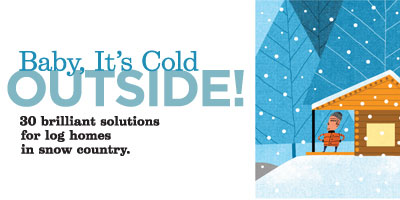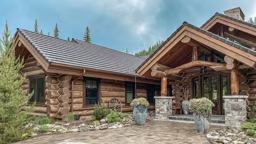
Although they spend most of their time deep in the heart of Texas, Gary and Susan Lawson of Dallas have the ability to check on their getaway home in Steamboat Springs, Colorado with just a few clicks of a mouse. Thanks to an Internet-enabled automation system, the Lawsons can track temperatures inside and outside of their getaway home or turn off the water supply in the event of a plumbing failure. "It's like peace of mind in a little black box," says Gary. "We can take a virtual visit and make sure everything's fine when we can't get away." When the couple does head to their vacation home, they can turn on the lights, have a fire burning in the gas hearth, and turn up the heat in the hot tub—all before they arrive. "I really get a kick out of it when we're heading up the driveway and see all the lights on," says Gary. Automation is one of many amenities that can make your snow country log home even smarter. We asked experts to share their top solutions for living in this sometimes demanding environment. Here are 30 design ideas to keep you cozy.
DESIGN DO'S
The Name's Mud.
For the ultimate sloppy-weather abode, choose a design with a large mudroom for drying and storing wet winter gear. In addition to a garage, also consider a portico to keep you and your guests dry when unloading luggage, groceries or gifts outside the front door. Ski Dreams. If you plan to entertain après ski, buffer your bedrooms from the common areas so some folks can rest after a long day of bump runs.
Eaves Dropping.
"To further protect exterior logs from the rain, snow and sun, you should also include larger eaves or overhangs in your roof design," says Jerry Koski, co-owner with his wife Linda of Koski Log Homes in Ontonagon, Michigan. "I frequently recommend a four-foot eave." Heavy Snowfall. Local building codes will dictate how much "snow weight" your new roof should safely support. "This can vary from 110 pounds per square foot in the Rockies, to a whopping 250 pounds in the Sierra Nevada Mountains," explains Loretta Kirkpatrick of Eastern Sierra Log Homes in Ridgecrest, California
Shingled Out.
If your building partner says shingles will work just fine in your area, common three-tab asphalt shingles run $25 to $40 per square, versus $50 to $70 per square for architectural shingles. Add another $25 to $50 per square for installation, depending on your region and the difficulty of your roof configuration.
POWER PLAYS
Great Indoors.
"To keep your log home warm and your energy bills low, you still want to invest in high-quality insulation," says David Gordon of Katahdin Cedar Log Homes in Oakfield, Maine. Choices include fiberglass batt, spray foam, blown-in cellulose, rigid foam and wool.
Glass Houses.
The weakest link in any home's thermal envelope is the windows. For better energy efficiency, invest in windows with a low U-value rating (around 0.33 or 0.34), which is worth the premium you'll pay for it. Insulated window cladding will also dramatically improve performance.
Heat Is On.
To stay toasty without burning money, buy an energy-efficient heating, ventilating and air conditioning (HVAC) system with a high Annual Fuel Utilization Efficiency rating (AFUE). Units are sold with AFUE rating stickers on the side. The least efficient AFUE is 78; the most efficient is 98.6.
Home Fires.
Cold nights and a warm fire go together like butter and popcorn. But your choice of hearths will depend on which fuels are accessible—and allowed by local building codes—in your area. There are eight basic fuels to choose from: wood, natural gas, propane, coal, oil, electricity, corn and wood pellets. You can burn these fuels in fireplaces, stoves, masonry heaters or inserts.
DRIVING SNOW
Car Cozy.
Nighttime temperatures can turn your automobile's oil into something that resembles wax. You can prevent this with an insulated and heated garage designed to house your cars, as well as toys like snowmobiles and ATVs.
Long Drive.
The longer your driveway, the more snow removal will cost—either in dollars or in back aches. So you may decide to site your log home closer to the road. Choose a driveway design that includes an area to put snow after plowing, as well as guest parking spaces. Also plan for plenty of landscape, walkway and porch lighting fixtures to prevent slips and falls.
MORE HOT TIPS
Tool Time.
When building in the high country, snow arrives early and stays late. This shorter construction season means you should select a builder who has a proven track record of completing log homes on tight deadlines.
Automation Nation.
"Home automation can cost $2,000 to more than $60,000 for all the bells and whistles," says Cecil Smart of Smart Lighting Design in Salt Lake City. One must-have is a keyless entry system ($100 to $250). Just think: No more fumbling for keys in the cold! Simply give out the code to guests and workmen, then change as needed. Colorado resident
Charles Bevier is editor of Building Systems magazine.
"To keep your log home warm and your energy bills low, you still want to invest in high-quality insulation," says David Gordon of Katahdin Cedar Log Homes in Oakfield, Maine. Choices include fiberglass batt, spray foam, blown-in cellulose, rigid foam and wool.
Glass Houses.
The weakest link in any home's thermal envelope is the windows. For better energy efficiency, invest in windows with a low U-value rating (around 0.33 or 0.34), which is worth the premium you'll pay for it. Insulated window cladding will also dramatically improve performance.
Heat Is On.
To stay toasty without burning money, buy an energy-efficient heating, ventilating and air conditioning (HVAC) system with a high Annual Fuel Utilization Efficiency rating (AFUE). Units are sold with AFUE rating stickers on the side. The least efficient AFUE is 78; the most efficient is 98.6.
Home Fires.
Cold nights and a warm fire go together like butter and popcorn. But your choice of hearths will depend on which fuels are accessible—and allowed by local building codes—in your area. There are eight basic fuels to choose from: wood, natural gas, propane, coal, oil, electricity, corn and wood pellets. You can burn these fuels in fireplaces, stoves, masonry heaters or inserts.
DRIVING SNOW
Car Cozy.
Nighttime temperatures can turn your automobile's oil into something that resembles wax. You can prevent this with an insulated and heated garage designed to house your cars, as well as toys like snowmobiles and ATVs.
Long Drive.
The longer your driveway, the more snow removal will cost—either in dollars or in back aches. So you may decide to site your log home closer to the road. Choose a driveway design that includes an area to put snow after plowing, as well as guest parking spaces. Also plan for plenty of landscape, walkway and porch lighting fixtures to prevent slips and falls.
MORE HOT TIPS
Tool Time.
When building in the high country, snow arrives early and stays late. This shorter construction season means you should select a builder who has a proven track record of completing log homes on tight deadlines.
Automation Nation.
"Home automation can cost $2,000 to more than $60,000 for all the bells and whistles," says Cecil Smart of Smart Lighting Design in Salt Lake City. One must-have is a keyless entry system ($100 to $250). Just think: No more fumbling for keys in the cold! Simply give out the code to guests and workmen, then change as needed. Colorado resident
Charles Bevier is editor of Building Systems magazine.








_11868_2024-09-17_08-44-256x288.avif)


